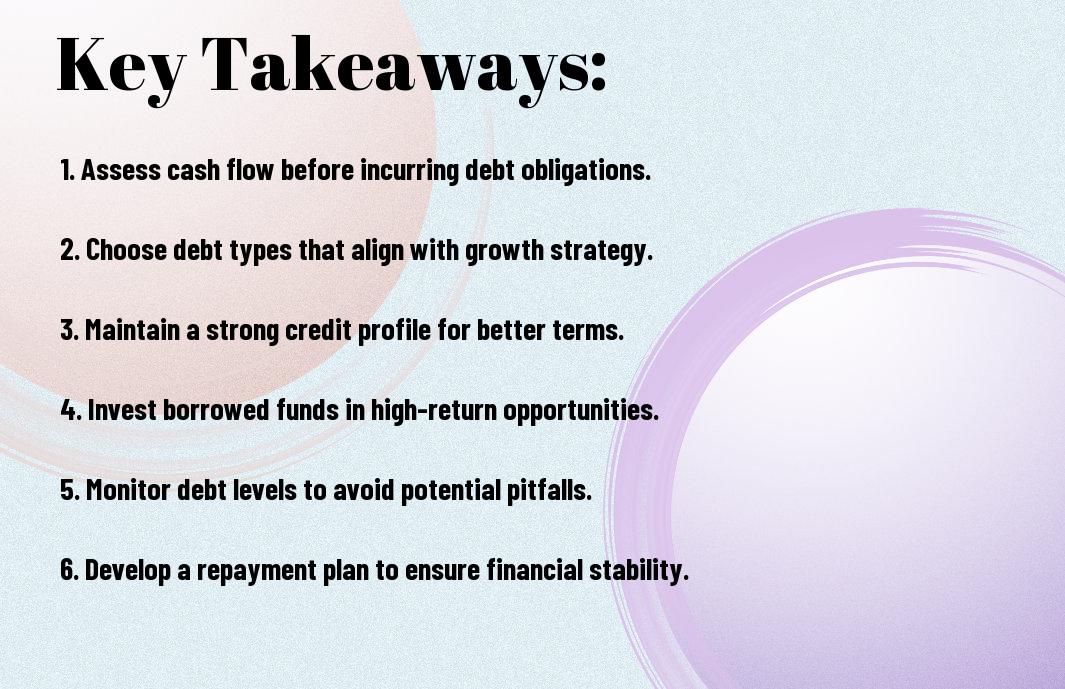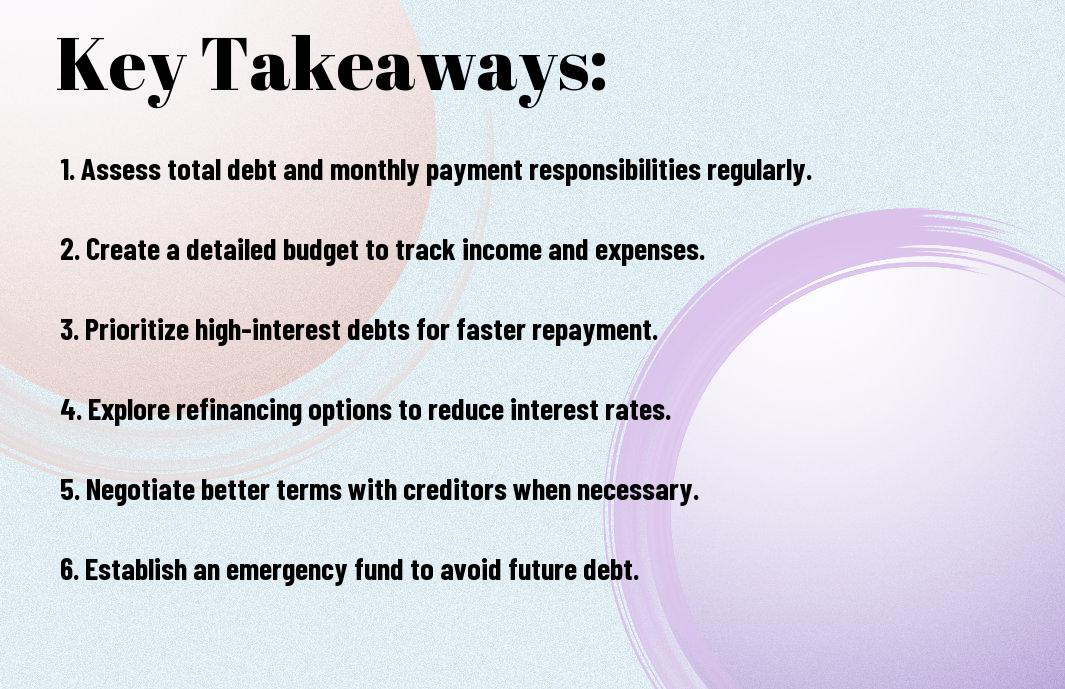Most entrepreneurs often overlook the potential of debt as a powerful tool for business growth. By understanding how to strategically manage borrowed funds, you can unlock significant opportunities for expansion, innovation, and increased profitability. This guide will provide you with practical insights on how to evaluate the right types of debt, implement effective financial strategies, and position your business for success, all while maintaining a healthy financial balance.
Key Takeaways:
- Understand Debt Types: Familiarize yourself with various debt options such as loans, lines of credit, and bonds to identify which best suits your business needs.
- Cash Flow Management: Maintain a strong grasp of your cash flow to ensure you can comfortably meet debt repayments while investing in growth.
- Growth Opportunities: Use debt strategically to finance expansion projects, such as new product lines, entering new markets, or acquiring other businesses.
- Cost of Borrowing: Analyze interest rates and terms carefully to determine the overall cost of debt and its impact on your business’s profitability.
- Risk Assessment: Evaluate the risks associated with taking on debt, including market fluctuations and economic downturns, to make informed decisions.

Understanding Business Debt
The first step in leveraging debt for business growth is understanding what constitutes business debt. Business debt refers to any amount of money that your company borrows and is obligated to repay. Recognizing the nature and function of different types of debt helps you make informed decisions that align with your growth strategy.
Types of Debt Instruments
- Bank Loans
- Credit Lines
- Commercial Mortgages
- Bonds
- Peer-to-Peer Lending
This variety of debt instruments allows you to choose the best fit for your financial needs and growth plans.
| Type of Debt Instrument | Description |
| Bank Loans | Long-term financing with fixed repayment terms. |
| Credit Lines | Flexible borrowing up to a credit limit. |
| Commercial Mortgages | Loans secured by commercial real estate. |
| Bonds | Debt securities issued to raise funds. |
| Peer-to-Peer Lending | Direct loans from individual investors, bypassing banks. |
Debt vs. Equity Financing
Before deciding on leveraging debt, it’s imperative to differentiate between debt and equity financing. While debt involves borrowing funds to be repaid over time, equity financing entails selling ownership stakes in your business. This decision impacts your financial structure and control, so evaluate both options thoroughly for long-term sustainability.
Business debt and equity financing serve distinct purposes in capital acquisition. Debt allows you to retain full ownership of your business while leveraging funds for growth, although it involves regular interest payments. In contrast, equity financing means sharing ownership with investors, which can dilute your control but may provide a more flexible repayment structure. Carefully assess your financial goals and risk tolerance when choosing between these financing methods.
Assessing Your Business Needs
One of the first steps in leveraging debt for business growth is assessing your business needs. Take the time to critically evaluate what areas of your business require funding, whether it’s for new equipment, hiring staff, or expanding your product line. Understanding these needs will enable you to make informed decisions about taking on debt. For insights on Strategically Leveraging Business Debt, look to expert resources that guide your financial strategies.
Identifying Growth Opportunities
Your ability to identify growth opportunities is fundamental to your business’s success. Evaluate market trends and customer feedback to spot areas where you can expand or improve your offerings. This proactive approach will lay the groundwork for targeted investment that drives growth, helping you align your debt strategy with clear, actionable goals.
Evaluating Financial Health
Across your business, assessing financial health is necessary before taking on new debt. Analyze your cash flow, profit margins, and existing liabilities to understand your current financial position. This analysis will support your decision-making process, ensuring that you only pursue growth opportunities that are sustainable and aligned with your financial capacity.
Also, consider developing a detailed financial projection that incorporates potential debt repayment scenarios. This will provide clarity on how much debt you can feasibly handle while still maintaining healthy operations. Be honest about your business’s financial status, as this understanding will empower you to make the best decisions for your growth trajectory.

Creating a Strategic Debt Plan
Many entrepreneurs overlook the necessity of a well-thought-out strategic debt plan. By proactively planning how you intend to leverage debt, you can align your borrowing with business goals, ensuring that your financial commitments support rather than hinder your growth. This structured approach allows you to identify opportunities, resource needs, and the types of financing that will work best for your business long-term.
Setting Clear Objectives
With clear objectives in place, you are better equipped to align your debt strategy with your overall business vision. Outline what you want to achieve with the borrowed funds, whether it’s expanding your product line, increasing inventory, or improving cash flow. Specific, measurable goals will guide your financial decisions and help you track your progress over time.
Choosing the Right Debt Structure
Debt structures can vary greatly, influencing your business’s financial health and flexibility. You should consider options such as term loans, lines of credit, or alternative financing sources, weighing the pros and cons of each. Selecting the most suitable structure will depend on your business needs, cash flow situation, and repayment ability, ensuring you can manage any obligations without sacrificing growth.
Plan to evaluate different debt instruments, focusing on factors such as interest rates, repayment terms, and any associated fees. Each structure has its benefits and drawbacks, so choose one that aligns with your growth strategy and financial capacity. For instance, a term loan might provide immediate capital for a project, while a line of credit offers flexibility for ongoing operational costs. Analyze your cash flow projections to determine which debt structure will support your objectives while minimizing risk.
Sourcing Financing Options
Not all funding sources are created equal, and it is vital to explore various financing options to find the best fit for your business growth. From traditional banks to inventive alternatives, understanding what’s available can empower you to make informed decisions that align with your goals. Assessing the pros and cons of different sources can help you secure the capital necessary for expansion.
Traditional Lenders
Traditional lenders, such as banks and credit unions, often provide loans with more favorable interest rates but require rigorous eligibility criteria. They typically assess your credit history, business plan, and financial statements, focusing on proven stability and cash flow. If you have a solid track record, traditional lenders can be a reliable and trustworthy source of financing.
Alternative Financing Solutions
Solutions like peer-to-peer lending, crowdfunding, and invoice financing offer flexible options when traditional banks may not be viable. These avenues can provide immediate cash flow and minimize the need for extensive documentation. As you explore these alternatives, keep in mind that while they may involve higher fees or varying interest rates, they can be ideal for specific needs or unique business circumstances.
At the forefront of alternative financing are platforms that connect you with individual investors or like-minded business owners for assistance. Such options can also include revenue-based financing, where repayments are tied to your earnings, making them accessible for businesses with fluctuating revenues. Moreover, invoice financing allows you to leverage outstanding invoices for immediate cash, freeing you up to reinvest in your operations. By understanding these alternatives, you can find a financing solution that matches your business’s specific needs and growth aspirations.
Managing and Utilizing Debt Effectively
Keep in mind that effective debt management involves understanding your financial landscape and using borrowed funds wisely. You should regularly assess your debt levels, ensuring they align with your business objectives. By developing a clear repayment plan and maintaining open communication with lenders, you can foster positive relationships that support your growth ambitions while keeping your financial health intact.
Monitoring Cash Flow
One of the key aspects of managing debt is keeping a close watch on your cash flow. Regular cash flow analysis allows you to anticipate financial shortfalls, enabling you to make informed decisions regarding debt repayment and funding new opportunities. This is vital to maintaining a balanced approach to both operational costs and debt obligations, ensuring that you can cover your liabilities when they come due.
Leveraging Debt for Expansion
After assessing your current financial standing, you can strategically use debt to fuel business expansion. This means not only investing in new projects but also ensuring those investments can generate additional revenue streams. By targeting high-potential areas, such as launching a new product line or entering a new market, you can utilize borrowed funds effectively to drive growth and increase your bottom line.
A well-thought-out expansion strategy can significantly amplify your business’s potential, and leveraging debt is often a necessary component of this. When you invest borrowed capital into projects with high return on investment (ROI), you can create a cycle of growth that improves your cash flow and strengthens your market position. Just be sure to conduct thorough risk assessments and financial forecasts to validate your expansion plans, as this diligence will help ensure that your debt is a powerful tool in driving your business forward.
Risks and Challenges of Using Debt
Your business can indeed benefit from leveraging debt, but it’s vital to understand the inherent risks and challenges. Overextending yourself can lead to cash flow problems, making it difficult to meet payment obligations. Additionally, market fluctuations and unexpected downturns can jeopardize your ability to repay loans, potentially placing your business in jeopardy. Careful planning and assessment are important to navigate these challenges effectively.
Understanding Debt Leverage
After recognizing the potential for growth through debt, it’s important to comprehend what debt leverage entails. This strategy involves using borrowed funds to invest in your business, aiming to increase your return on investment. While this approach can accelerate growth, it also increases your financial obligations, which necessitates a thorough understanding of how to manage these liabilities responsibly.
Strategies for Mitigation
Along with understanding the risks, you should develop effective strategies to mitigate potential downsides. Maintaining a detailed cash flow forecast is paramount, allowing you to anticipate and manage payment obligations. Establishing a robust financial cushion can also help you navigate unexpected challenges, ensuring you remain solvent even during downturns.
Risks associated with leveraging debt can be managed through diligent planning and vigilant monitoring of your financial health. By setting limits on your borrowing and assessing your ability to repay before taking on debt, you create a safety net. Consistent communication with lenders is also important so that you can adapt your strategies as conditions change. This proactive approach empowers you to utilize debt as a tool for growth while keeping potential pitfalls at bay.
Conclusion
Upon reflecting, you can effectively leverage debt to propel your business growth by strategically managing borrowed funds. By understanding your options and aligning them with your business goals, you can invest in opportunities that increase revenue. Always evaluate your debt capacity and ensure that your cash flow supports repayment. For further insights, consider exploring the 7 Ways to Improve Your Business By Leveraging Debt, which can guide you in optimizing your approach to financing your growth.
FAQ
Q: What is leveraging debt and how can it benefit my business?
A: Leveraging debt involves borrowing funds to invest in the growth of your business while using your existing assets as collateral. This strategy allows you to access capital that can expedite expansion, such as purchasing inventory, hiring staff, or investing in marketing campaigns. When used wisely, leveraging debt can enhance your business’s cash flow by allowing you to undertake projects that may generate higher returns than the cost of the debt itself. However, it’s important to assess your ability to repay the borrowed amount to mitigate potential risks.
Q: What types of debt can I use to leverage for business growth?
A: There are several types of debt options available for business growth. Common forms include traditional bank loans, lines of credit, credit cards, and alternative financing such as peer-to-peer lending or crowdfunding. Each type of debt has its own terms, interest rates, and repayment schedules, so it is crucial to evaluate which option aligns best with your business goals. Secured loans, where you provide collateral, often have lower interest rates compared to unsecured loans, but come with added risk for your assets.
Q: How can I ensure I’m using debt responsibly to foster growth?
A: To use debt responsibly, start by creating a comprehensive business plan that outlines your financing needs, projected expenses, and anticipated revenue. Conduct a thorough risk assessment to determine how much debt your business can comfortably manage while maintaining operational stability. It’s also advisable to maintain a healthy debt-to-equity ratio, ensuring that you do not overextend your financial commitments. Consistent monitoring of cash flow, establishing a solid repayment plan, and seeking professional financial advice when necessary can help you manage debt effectively while promoting sustainable growth.


